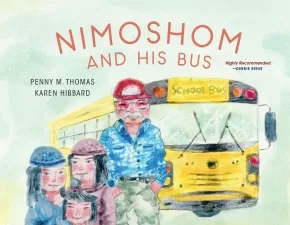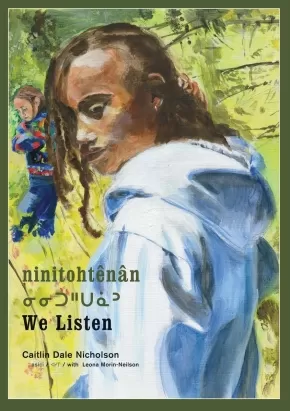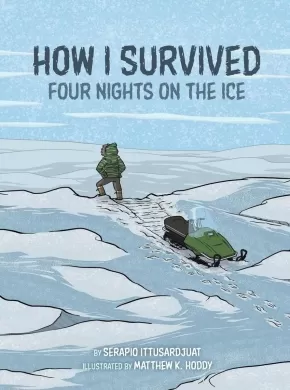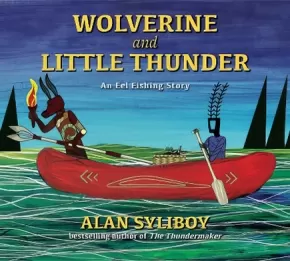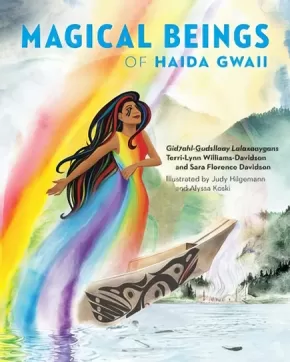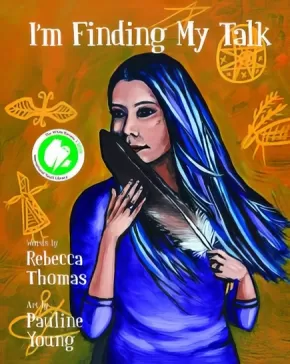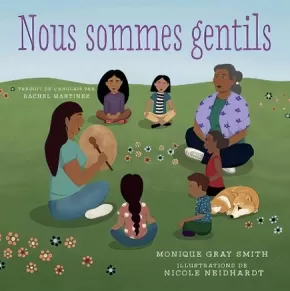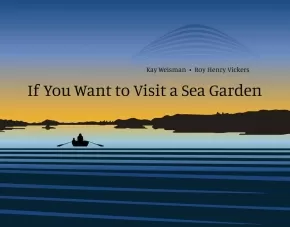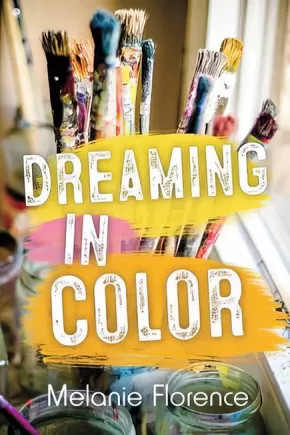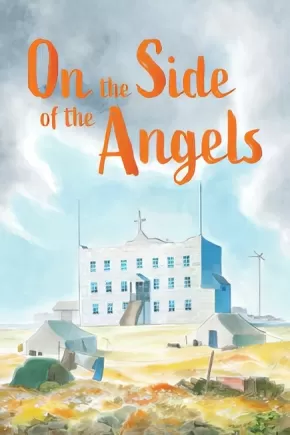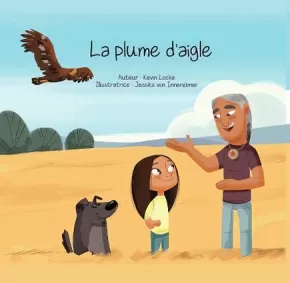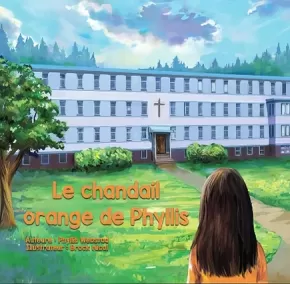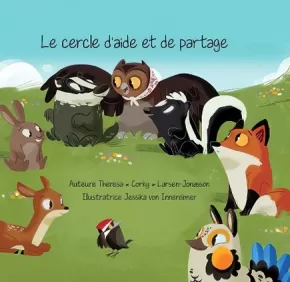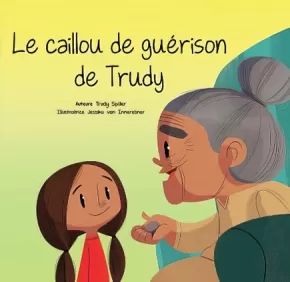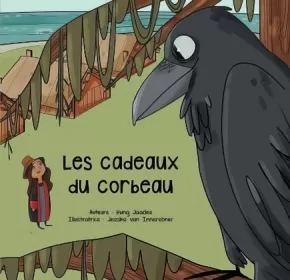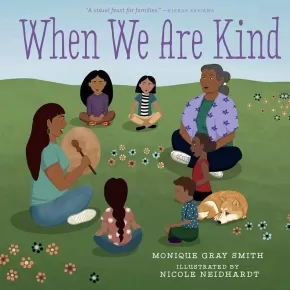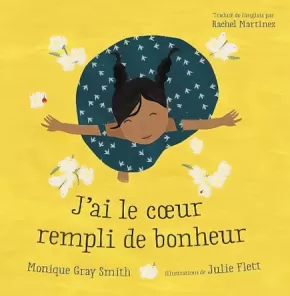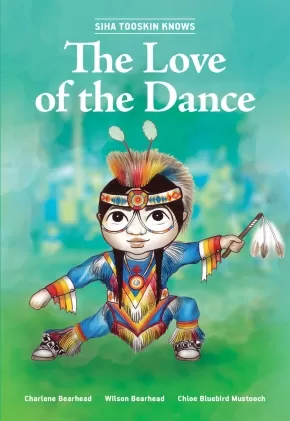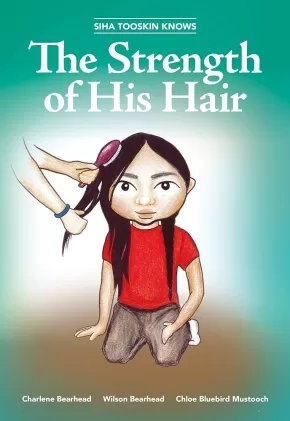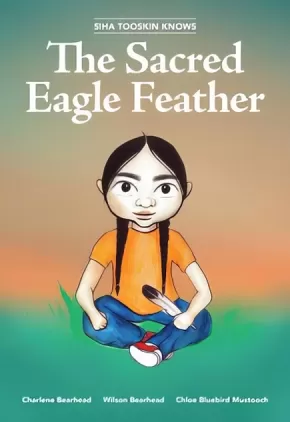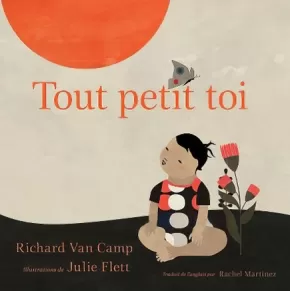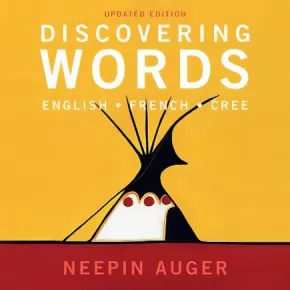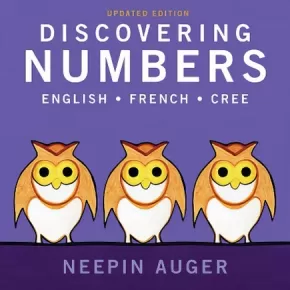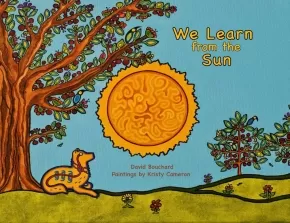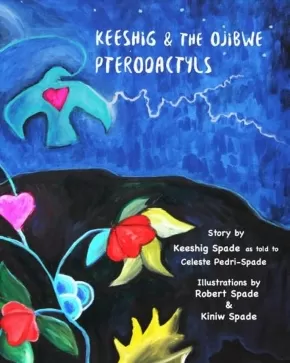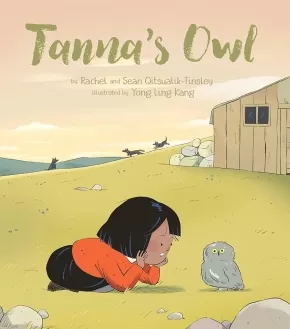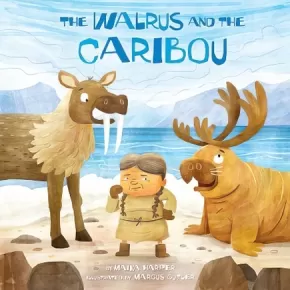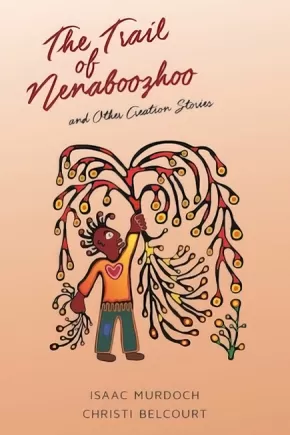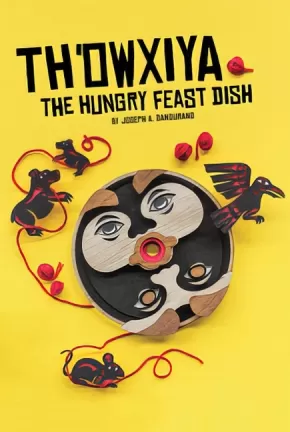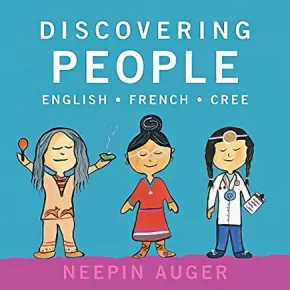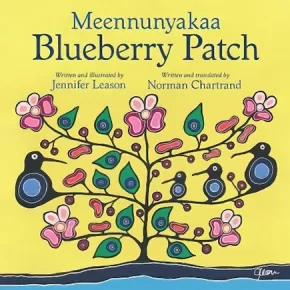
Previous Years' Selections
1
-
15
of
176 Results;
Sort By
Go To
of 12
Pow-wow: Je compte en cri
$12.99
Artists:
Format:
Paperback
Text Content Territories:
Indigenous Canadian; First Nations; Cree (Nehiyawak);
Grade Levels: Preschool; Kindergarten;
ISBN / Barcode: 9781039709447
Synopsis:
Synopsis:
Apprenez à compter jusqu’à dix en cri grâce aux images et aux sons d’un pow-wow.
Ce livre de comptage unique initie les enfants aux chiffres d’un à dix en cri des plaines. À chaque page, vous découvrirez des illustrations vibrantes qui reflètent la richesse de la culture et des traditions du peuple cri. Grâce aux rimes, au rythme et aux illustrations représentatives des pow-wow, ce livre fait de l’apprentissage des langues une expérience joyeuse pour les jeunes lecteur·rices.
Educator Information
Recommended for ages 3 to 8.
Recommended for ages 3 to 8.
This book is available in English: Powwow Counting in Cree
Additional Information
24 Pages | Paperback
24 Pages | Paperback
FLASH SALE! Elements of Indigenous Style: A Guide for Writing By and About Indigenous Peoples - 2nd Edition
$20.97 $27.95
Editors:
Format:
Paperback
Text Content Territories:
Indigenous Canadian;
Reading Level: N/A
ISBN / Barcode: 9781550599459
Synopsis:
Synopsis:
The groundbreaking Indigenous style guide every writer needs.
The first published guide to common questions and issues of Indigenous style and process for those who work in words and other media is back in an updated new edition. This trusted resource offers crucial guidance to anyone who works in words or other media on how to work accurately, collaboratively, and ethically on projects involving Indigenous Peoples.
Editor Warren Cariou (Métis) and contributing editors Jordan Abel (Nisga’a), Lorena Fontaine (Cree-Anishinaabe), and Deanna Reder (Cree-Métis) continue the conversation started by the late Gregory Younging in his foundational first edition. This second conversation reflects changes in the publishing industry, Indigenous-led best practices, and society at large, including new chapters on author-editor relationships, identity and community affiliation, Two-Spirit and Indigiqueer identities, sensitivity reading, emerging issues in the digital world, and more.
This guide features:
- Twenty-two succinct style principles.
- Advice on culturally appropriate publishing practices, including how to collaborate with Indigenous Peoples, when and how to seek the advice of Elders, and how to respect Indigenous Oral Traditions and Traditional Knowledge.
- Terminology to use and to avoid.
- Advice on specific editing issues, such as biased language, capitalization, citation, accurately representing Indigenous languages, and quoting from historical sources and archives.
- Examples of projects that illustrate best practices.
Additional Information
208 pages | 5.50" x 7.50" | Paperback
The Pencil (PB)
$14.95
Artists:
Format:
Paperback
Text Content Territories:
Indigenous Canadian; Inuit;
ISBN / Barcode: 9781772275377
Synopsis:
Synopsis:
Susan and her sister, Rebecca, love watching their mother write letters to people in other camps. Their mother has one precious pencil, and she keeps it safe in her box for special things. One afternoon, their mother leaves the iglu to help a neighbour, and Susan, Rebecca, and their brother Peter are left with their father. They play all their regular games but are soon out of things to do—until their father brings out the pencil! As Susan draws and draws, the pencil grows shorter and shorter. What will their mother think when she comes home? Based on author Susan Avingaq’s childhood memories of growing up in an iglu, this charming story introduces young readers to the idea of using things wisely.
Reviews
[A] wonderful and touching story about resilience and thrift and community. The illustrations are appropriately done in pencil, and they are playful and open and beautiful." — The New York Times Book Review
"[A] rich and moving story about how small things can make a tremendous difference in children’s lives...Avingaq’s childhood is beautifully evoked in this charming story about the need to take care of our belongings." — The Globe and Mail
"Authors Avingaq and Vsetula understand life in Nunavut, Canada, and embed in the story the importance of being responsible for belongings and caring for them wisely...A breath of warmth from the far north." — Kirkus Reviews
"A family-focused story with a light moral that lovingly illuminates a lifestyle rarely seen in children’s books." — School Library Journal
"The Pencil goes beyond a lesson in frugality and becomes a story of family, of play and of culture, which many children will appreciate." — CanLit for Little Canadians
Educator Information
Recommended for ages 6 to 8.
Additional Information
36 pages | 9.00" x 7.50" | Paperback
Nimoshom and His Bus (PB)
$14.00
Artists:
Format:
Paperback
Text Content Territories:
Indigenous Canadian; First Nations; Cree (Nehiyawak);
Grade Levels: Preschool; Kindergarten;
ISBN / Barcode: 9781774921166
Synopsis:
Synopsis:
In this warm and joyful picture book highly recommended by Debbie Reese, children learn Cree from Nimoshom, their school bus driver.
Based on the author’s memories of her grandfather, Nimoshom is not your average bus driver. He loves to drive the school bus, tell silly stories, and share his language with the kids who ride his bus.
Nimoshom and His Bus introduces readers to common Cree words and phrases alongside the common childhood experience of riding the school bus. A Cree word list is included in the back of the book.
Reviews
"Through accessible language and engaging visual resources, readers are introduced to basic Cree as Nimoshom responds in this language to the children who ride his bus.... The illustrator’s varying the visuals between full double spreads and single page illustrations keeps the pacing lively. Amidst a rural fall setting, with woodland animals, children, and the school bus, Nimoshom’s humorous nature shines through these gentle illustrations. At the end of this story, you just want to give Nimoshom a great big hug!"— Anita Miettunen, CM: Canadian Review of Materials
"In this bilingual book, readers follow a bus driver picking up kids and dropping them off before and after school. Like the students on the bus, readers quickly learn that the driver's native language is Cree, and he often speaks to them in his native language. Readers learn that "Nimoshom" means "my grandfather" and that "Ekosani" means thank you" as the author (of Cree descent herself) weaves Cree words into the text, and each new spread almost feels like a gentle wave: yes, we're subtly learning new words, but it never feels strenuous or forced, rather it's calm and poetic."— Let's Talk Picture Books
"While Penny M. Thomas' story is not a plot-driven allegory or a message-based lesson, Nimoshom and His Bus is a sweet introduction to some simple Cree words in the context of a common-place activity for many children.... Karen Hibbard who uses watercolours and pastels to create a gentle background for Nimoshom's day on his bus gives the story a grassroots mood, highly appropriate for a routine day of activity and interaction for this bus driver and his charges. It's very relatable."— Helen Kubiw, CanLit for Little Canadians
"If you're a regular reader of AICL, you know that we're always delighted by books by Native writers--especially ones set in the present. Books like Nimoshom and His Bus provide Native children with mirrors that non-Native children find in abundance.... I highly recommend Nimoshom and His Bus! It'd be a simple thing to use other Native words in addition to--or instead of--the Cree words in the book."— Debbie Reese, American Indians in Children's Literature
Educator Information
Recommended for ages 3 to 5.
Additional Information
24 pages | 9.50" x 7.50" | Paperback
ninitohtênân / We Listen
$21.99
Artists:
Format:
Hardcover
Text Content Territories:
Indigenous Canadian; First Nations; Cree (Nehiyawak);
ISBN / Barcode: 9781773068596
Synopsis:
Synopsis:
The third book in the Nôhkom series, in Cree and English, tells a story about gathering leaves for Labrador tea, while listening in different ways.
A child, her family and her friend have arrived at their favorite picnic spot by the lake, but before they eat lunch Nôhkom suggests they pick leaves for Labrador tea. Once among the trees, Nôhkom pauses for a moment to listen, and the others do too. Nôhkom prays, the girls take their turn, then Nôhkom shows them where to find the leaves. Nôhkom and Mom rest after harvesting, but the girls opt for a swim in the lake ... though they're quite happy to warm up afterwards with freshly brewed Labrador tea. And when it's time for the picnic, the girls take another turn at listening.
Beautifully rendered paintings in acrylic on canvas show the family outing. Includes a recipe for Labrador tea as well as a salve made from Labrador Tea leaves.
Educator Information
Recommended Ages: 3 to 7.
Written in short sentences in Cree and English (with Cree text appearing in standard roman orthography and syllabics), the book is a good choice for beginning readers and/or language learners.
This book is the third book in the Nôhkom series.
The story features different forms of listening — in the bush, to teachings from Nôhkom, to the conversation of family and friends (when listening can be especially fun!).
Key Text Features
illustrations
recipe
informational note
Correlates to the Common Core State Standards in English Language Arts:
CCSS.ELA-LITERACY.RL.1.2
Retell stories, including key details, and demonstrate understanding of their central message or lesson.
CCSS.ELA-LITERACY.RL.1.7
Use illustrations and details in a story to describe its characters, setting, or events.
Authenticity Note: Translator Leona Morin-Neilson is the inspiration for the stories and art in the Nôhkom series, which highlights her traditional knowledge of the uses of wild plants. She collaborated with the author to create this work and translated it into Cree.
Because of the collaboration between Leona and the author, and Leona's Cree translation, this book has been labelled as containing Authentic Indigenous Text. It is up to readers to determine if this work is authentic for their purposes.
Additional Information
24 pages | 8.50" x 12.25" | Hardcover
How I Survived: Four Nights on the Ice (PB)
$18.95
Artists:
Format:
Paperback
Text Content Territories:
Indigenous Canadian; Inuit;
ISBN / Barcode: 9781772274264
Synopsis:
Synopsis:
After his snowmobile breaks down halfway across the sea ice on a trip back from a fishing camp, Serapio Ittusardjuat recounts the traditional skills and knowledge he leaned on to stay alive.
This harrowing first-person account of four nights spent on the open sea ice—with few supplies and no water—shows young readers the determination and strength necessary to survive in the harsh Arctic climate, even when the worst occurs.
Awards
- 2022 Forest of Reading—Silver Birch Express Award
Reviews
"[T]he graphic novel How I Survived is a true story of Arctic survival written by Serapio Ittusardjuat, an Inuk stone carver and former mechanic.... This beautifully designed, highly engaging graphic novel should engross both reluctant readers and those seeking adventure." - Quill & Quire
Educator Information
Recommended for ages 12+
The original hardcover version was included in the Indigenous Books for Schools 2020/2021 resource list as being useful for grades 6 to 9 for English Language Arts and Social Studies.
Additional Information
48 pages | 7.25" x 9.75"
The Origin of Day and Night (PB)
$13.95
Artists:
Format:
Paperback
Text Content Territories:
Indigenous Canadian; Inuit;
ISBN / Barcode: 9781772274691
Synopsis:
Synopsis:
In very early times, there was no night or day and words spoken by chance could become real. When a hare and a fox meet and express their longing for light and darkness, their words are too powerful to be denied. Passed orally from storyteller to storyteller for hundreds of years, this beautifully illustrated story weaves together elements of an origin story and a traditional animal tale, giving young readers a window into Inuit mythology.
Educator Information
Recommended in a Canadian Indigenous Books for Schools resource list as being useful for grades 2-5 in these subject areas: English Language Arts, Social Studies.
Useful as a read-aloud, independent read, or information resource for students.
Additional Information
32 pages | 9.00" x 8.00" | Paperback
The Spirit Trackers (PB)
$14.95
Artists:
Format:
Paperback
Text Content Territories:
Indigenous Canadian; First Nations; Anishinaabeg;
ISBN / Barcode: 9781771770187
Synopsis:
Synopsis:
Will and Tom speak in a whisper.
"Uncle, tell us the story of the Windigo."
The boys look behind them for something they can't see.
When Uncle shares the story of the Windigo, the cousins get more than they expect. That night something strange scratches at the frost on their bedroom window. In the morning they find huge tracks in the snow. The Wandering Night Spirit of Winter!
Tom and Will know what good Trackers would do, so they follow the trail deep into the forest. Then a strange cry slices the air.
"Remember," Will whispers as they move forward. "Don't look into its eyes."
Can you be a tracker too? Find the tracks hidden in the pictures.
Reviews
"Gorgeous illustrations and suspenseful writing fully engross the reader and have my kids sitting on the edge of their seats every time. This emotional engagement makes it a perfect read for discussing the concept of bravery, while the story's details provide wonderful cultural education. And as a fun bonus, the endpapers show different animal tracks that you can spot throughout the book - just like good Trackers!"— Read. Learn. Repeat. Blog
"Richly illustrated in mixed media, Waboose weaves a story of respect for nature and family. The boy's insistence of their bravery is countered by their natural fear of the unknown — and the stories they have heard. A great read for a stormy winter night. Beware of the Windigo!"— kissthebookjr.blogspot.com
"Anishinaabe Waboose's prose seamlessly threads her people's legends with her story of a modern First Nations family that is keeping its traditions alive. Award-winning illustrator Thisdale's expressive and detailed illustrations add depth to Waboose's engaging text. His mixed-media paintings successfully blend the traditional and the modern, the comfortably familiar and the uncanny, to support the story's themes. An intergenerational tale that celebrates both a specific tradition and the universal curiosity of children."— Kirkus Starred Review
Educator Information
Recommended in the Canadian Indigenous Books for Schools 2019-2020 resource list as being useful for grades K-4 for English Language Arts.
Young readers will be able to improve their tracking skills as they find clues hidden in the illustrations along with Will and Tom.
Additional Information
32 pages | 8.50" x 11.00" | Paperback
Wolverine and Little Thunder: An Eel Fishing Story (PB) (2 in stock, In reprint )
$14.95
Artists:
Format:
Paperback
Text Content Territories:
Indigenous Canadian; First Nations; Mi'kmaq;
ISBN / Barcode: 9781774710906
Synopsis:
Synopsis:
Celebrated Mi'kmaw artist behind The Thundermaker returns with a story about friendship and the importance of traditional knowledge.
From the bestselling creator of The Thundermaker comes another adventure featuring Little Thunder and Wolverine — a trickster, who is strong and fierce and loyal. The two are best of friends, even though Wolverine can sometimes get them into trouble. Their favourite pastime is eel fishing, whether it's cutting through winter ice with a stone axe or catching eels in traditional stone weirs in the summer. But that all changes one night, when they encounter the giant river eel — the eel that is too big to catch. The eel that hunts people!
At once a universal story of friendship and problem-solving, Wolverine and Little Thunder is a contemporary invocation of traditional Mi'kmaw knowledge, reinforcing the importance of the relationship between the Mi'kmaq and eel, a dependable year-round food source traditionally offered to Glooscap, the Creator, for a successful hunt.
Educator Information
Recommended ages: 4-8
Additional Information
40 pages | Paperback
Magical Beings of Haida Gwaii (PB)
$14.95
Format:
Paperback
Text Content Territories:
Indigenous Canadian; First Nations; Haida;
ISBN / Barcode: 9781772033700
Synopsis:
Synopsis:
Based on ancient Haida narratives, this vibrantly illustrated children's book empowers young people and teaches them to live in harmony with nature.
Haida Gwaii is home to a rich and vibrant culture whose origins date back thousands of years. Today, the Haida People are known throughout Canada and the world for their artistic achievements, their commitment to social justice and environmental protection, and their deep connection to the natural world. Embedded in Haida culture and drawn from ancient oral narratives are a number of Supernatural Beings, many of them female, who embody these connections to the land, the sea, and the sky. Magical Beings of Haida Gwaii features ten of these ancient figures and presents them to children as visually engaging, empowering, and meaningful examples of living in balance with nature. Developed by renowned Haida activist, lawyer, performer, and artist Terri-Lynn Williams-Davidson and Haida educator Sara Florence Davidson, this book challenges stereotypes, helps advance reconciliation, and celebrates Indigenous identity and culture.
Reviews
"Magical Beings of Haida Gwaii is a gentle, powerful collection of words and pictures, stories that hold knowledge, teachings, and traditions for the generations of today and the future. A must-read for those who live on the beautiful island of Haida Gwaii, and any Canadian who wants to learn about one of the many vital Indigenous cultures across Turtle Island." — David A. Robertson, winner of the Governor General’s award for When We Were Alone
"Magical Beings of Haida Gwaii is an enchanting book born of a close relationship and understanding of how we see the world from an Indigenous perspective. There is an intrinsic value to stories recorded from the most natural of primary sources, our families. Terri-Lynn and Sara Davidson have given us a lesson on how to value our Indigenous magical beings as we all have them."— Naa-Jing-Jada, Verna J. Kirkness, educator and author of Creating Space: My Life and Work in Indigenous Education
"An absolute treasure and honouring for the Haida People and for Haida Gwaii, and a marvel of devotion for the world to learn from. Oh I love this book so much! I am in awe of Magical Beings of Haida Gwaii. Every Nation deserves a book as gorgeous and as healing as this one." — Richard Van Camp, award-winning author of Moccasin Square Gardens
Educator Information
Recommended for ages 5 to 8.
Recommended in the Canadian Indigenous Books for Schools 2020/2021 resource list for grades 2 to 9 for English Language Arts, Fine Arts, and Social Studies.
Includes a glossary and pronunciation guide at the back.
A Colouring and Activity Book for this work can be found here: Magical Beings of Haida Gwaii Colouring and Activity Book
Additional Information
64 pages | 8.00" x 10.00" | Paperback
I'm Finding My Talk (PB)
$13.95
Artists:
Format:
Paperback
Text Content Territories:
Indigenous Canadian; First Nations; Mi'kmaq;
ISBN / Barcode: 9781774710067
Synopsis:
Synopsis:
I'm finding my talk
And it may take some time,
But I'm learning to speak
In a language that's mine.
A response to Rita Joe's iconic poem "I Lost My Talk," and published simultaneously with the new children's book edition illustrated by Pauline Young, comes a companion picture book by award-winning spoken-word artist and Mi'kmaw activist Rebecca Thomas. A second-generation residential school survivor, Thomas writes this response poem openly and honestly, reflecting on the process of working through the destructive effects of colonialism.
From sewing regalia to dancing at powow to learning traditional language, I'm Finding My Talk is about rediscovering her community, and finding culture. Features stunning, vibrant illustrations by Mi'kmaw artist Pauline Young.
Reviews
"Published as a companion to the picture book I Lost My Talk, featuring the famous poem by Rita Joe, both volumes explore the legacy of Canada’s residential schools. They feature vibrant illustrations by Pauline Young that bring the words alive with emotional nuance. This remarkable pair of books possesses the rare ability of being suited to readers of all ages: three to six-year-olds, the traditional intended audience of picture books, will be captivated by the bright, lively illustrations; elementary and middle school children will find their Social Studies curriculum enriched by experiencing these important concepts rendered creatively; teens and adults will gain insight and empathy by enjoying these beautiful poems." - CM Reviews
"[A]n honest reflection on the process of working through the destructive effects of colonialism by participating in cultural connections. This book offers the opportunity to show the journey one takes when rediscovering their community and culture." - The Dalai Lama Center
Educator Information
Recommended for ages 4 to 9.
Recommended in the Canadian Indigenous Books for Schools 2020/2021 resource list for grades 1-3 in the areas of Social Studies and Language Arts.
Former Halifax Poet Laureate and second-generation residential school survivor Rebecca Thomas writes honestly and powerfully in this companion piece to Rita Joe's I Lost My Talk. Includes vibrant illustrations from Mi'kmaw artist Pauline Young.
Additional Information
32 pages | 8.00" x 10.00"
I Lost My Talk (PB)
$13.95
Artists:
Format:
Paperback
Text Content Territories:
Indigenous Canadian; First Nations; Mi'kmaq;
ISBN / Barcode: 9781774710050
Synopsis:
Synopsis:
I lost my talk
The talk you took away
When I was a little girl
At Shubenacadie school.
One of Rita Joe's most influential poems, "I Lost My Talk" tells the revered Mi'kmaw Elder's childhood story of losing her language while a resident of the residential school in Shubenacadie, Nova Scotia. An often quoted piece in this era of truth and reconciliation, Joe's powerful words explore and celebrate the survival of Mi'kmaw culture and language despite its attempted eradication.
A companion book to the simultaneously published I'm Finding My Talk by Rebecca Thomas, I Lost My Talk is a necessary reminder of a dark chapter in Canada's history, a powerful reading experience, and an effective teaching tool for young readers of all cultures and backgrounds. Includes a biography of Rita Joe and striking colour illustrations by Mi'kmaw artist Pauline Young.
Reviews
"This picture book version of I Lost My Talk is best read with Rebecca Thomas’s I’m Finding My Talk. These haunting, evocative books bring an original approach to the exploration of Canadian residential schools in picture books. For readers and teachers who appreciate fact-based information, there is also “A Short History of Residential Schools” at the end of I Lost My Talk. Educators, librarians, and families will find their classrooms and book collections invaluably enriched by these books. They are real tools of truth and reconciliation; as such, they belong on every bookshelf in Canada and beyond." - CM Reviews
Educator Information
Recommended for ages 4 to 9.
This work features a short history of residential schools and information about the author.
Recommended in the Canadian Indigenous Books for Schools 2020/2021 resource list for grades 1-7 for English Language Arts.
Additional Information
32 pages | 8.00" x 10.00"
Nous sommes gentils
$21.95
Artists:
Format:
Hardcover
Text Content Territories:
Indigenous American; Native American; Indigenous Canadian;
ISBN / Barcode: 9781459826502
Synopsis:
Synopsis:
Nous sommes gentils traite des gestes de bonté tout simples du quotidien et encourage les enfants à explorer comment ils se sentent quand ils sont bienveillants ou quand une personne est gentille à leur égard. L’autrice renommée Monique Gray Smith a écrit de nombreux ouvrages sur la résilience et la réconciliation. Elle communique un message important qui s’adresse aux lecteurs de tous les âges au moyen de mots soigneusement choisis. Magnifiquement illustré par l’artiste Nicole Neidhardt, l’album encourage les enfants à être gentils avec les autres et avec eux-mêmes.
Educator Information
Recommended for ages 3 to 5.
Recommended in the Canadian Indigenous Books for Schools 2020/2021 resource list as useful for grades K to 4 as a French resource.
This book is also available in English: When We Are Kind
This book is available in English as a board book: When We Are Kind (BB)
This book is also available in a dual-language format: When We Are Kind / Nihá’ádaahwiinít’íįgo
Additional Information
32 pages | 9.00" x 9.00"
If You Want to Visit a Sea Garden
$18.99
Format:
Hardcover
Text Content Territories:
Indigenous Canadian;
ISBN / Barcode: 9781554989706
Synopsis:
Synopsis:
Discover the wonder of ancient sea gardens on the Northwest Coast
Sea gardens have been created by First Peoples on the Northwest coast for more than three thousand years. These gardens consist of stone reefs that are constructed at the lowest tide line, encouraging the growth of clams and other marine life on the gently sloped beach.
This lyrical story follows a young child and an older family member who set out to visit a sea garden early one morning, as the lowest tides often occur at dawn. After anchoring their boat, they explore the beach, discover the many sea creatures that live there, hear the sputtering of clams and look closely at the reef. They reflect on the people who built the wall long ago, as well as those who have maintained it over the years. After digging for clams, they tidy up the beach, then return home.
An author’s note provides further information about sea gardens (also known as clam gardens), which yield a reliable food source and have been traditional places of learning. They have been found along the Pacific coast, from Alaska to British Columbia to Washington State, and some of these gardens are being restored today.
The manuscript has been vetted and approved by the scientists of the Clam Garden Network and Kwaxsistalla Wathl’thla Clan Chief Adam Dick. Roy Henry Vickers, whose ancestry includes the Tsimshian, Haida and Heiltsuk First Nations, has created hauntingly beautiful images to accompany the text.
Reviews
“The text and illustrations combine grace and knowledge, offering a stunning nonfiction picture book that celebrates First Nations cultural traditions.” — School Library Journal
“This engaging tale is a natural for lessons about ecology and units on Indigenous peoples, and the illustrations will pop for story-hour audiences.” — Booklist
Educator Information
Recommended for ages 5 to 8.
Recommended in the Indigenous Books for Schools 2020/2021 resource list as being useful for grades K to 3 for Science and Social Studies.
Additional Information
32 pages | 10.25" x 8.50"
Dreaming in Color
$10.95
Format:
Paperback
Text Content Territories:
Indigenous Canadian;
ISBN / Barcode: 9781459825864
Synopsis:
Synopsis:
Jennifer McCaffrey has been working hard on her art for years and is thrilled when she is accepted to a prestigious art school. The school is everything she always thought it would be, mostly. There is one group of kids who seem to resent her and say she only got in because of her skin color. Jen, who loves to create new pieces of artwork that incorporate her Indigenous heritage, finds herself a target when the group tells her to stop being “so Indian”. The night before the big art show at school, Jen’s beading art project is defaced. Jen has to find a way not to let the haters win.
Reviews
“Offers a mirror to the sometimes painful emotions and everyday experiences of Indigenous teens of mixed heritage. A rare and welcome reluctant reader title featuring an Indigenous protagonist.” — Kirkus Reviews
“Through the novel’s accessible language and short chapters, readers of all levels and backgrounds will be able to relate to and learn from Jen’s overcoming racial prejudice and intolerance. Readers will also gain a sense of empathy as they come to understand the struggles faced by Indigenous youth in contemporary society. Highly Recommended.” — CM: Canadian Review of Materials
Educator & Series Information
Recommended for ages 12+
Fry Reading Level: 3.4
Themes: racism, prejudice, standing up to bullies, cultural pride, Indigenous art
Dreaming in Color is a companion novel to the bestselling He Who Dreams (the main character is John's sister).
New, enhanced features (dyslexia-friendly font, cream paper, larger trim size) to increase reading accessibility for dyslexic and other striving readers.
Recommended in the Canadian Indigenous Books for Schools 2020/2021 resource list for grades 6 to 9 for English Language Arts.
This is an Orca Soundings book. Orca Soundings are short, high-interest novels written specifically for teens. These edgy stories with compelling characters and gripping storylines are ones they will want to read.
Additional Information
144 pages | 5.00" x 7.50"
Making a Whole Person: Traditional Inuit Education (2 in stock, Out of Print)
$22.95
Artists:
Format:
Hardcover
Text Content Territories:
Indigenous Canadian; Inuit;
ISBN / Barcode: 9781774502051
Synopsis:
Synopsis:
“Before schools were introduced to the Inuit, we were taught by our relatives.”
In this picture book, Monica Ittusardjuat shares how she learned knowledge and skills in a time before being taken to residential school. She describes how children learned through playing games, imitating grown-ups, and observing adults around them.
Educator & Series Information
Recommended for ages 7 to 9.
Inhabit Education Books is proud to introduce Qinuisaarniq (“resiliency”), a program created to educate Nunavummiut about the history and impacts of residential schools, policies of assimilation, and other colonial acts that affected the Canadian Arctic. This book is a part of that program.
Each resource in the program has been carefully written and reviewed to include level-appropriate opportunities for students to learn about colonial acts and policies that affected Inuit. Topics covered include the residential school system, relocations to settlements and the High Arctic, sled dog slaughters, the use of E and W numbers, and others. These acts and policies created long-lasting impacts on Inuit individuals and communities, which are still being felt today.
The resources in this program include personal interviews, testimony, and writing; non-fiction informational resources; and information about traditional Inuit practices.
This resource is included in the Canadian Indigenous Books for Schools 2020/2021 list as being useful for grades 2 to 4 for English Language Arts and Social Studies.
Additional Information
26 pages | 8.00" x 9.00"
On the Side of the Angels
$12.95
Artists:
● Hwei Lim
Format:
Paperback
Text Content Territories:
Indigenous Canadian; Inuit;
ISBN / Barcode: 9781774502037
Synopsis:
Synopsis:
"Then one day a ‘flyable’ took me away from our world through the sky to a dark and desolate place.”
Jose Kusugak had a typical Arctic childhood, growing up playing games, enjoying food caught by hunters, and watching his mother preparing skins. But he was one of the first generation of Inuit children who were taken from their homes and communities and sent to live in residential schools. In this moving and candid memoir, Jose tells of his experiences at residential school and the lifelong effects it had on him.
Educator & Series Information
Recommended for ages 12 to 15.
Included in the Canadian Indigenous Books for Schools 2020/2021 resource list for grades 6 to 9 for Social Studies, Science, and English Language Arts.
A personal, real story that introduces young readers to the memoir genre.
Inhabit Education Books is proud to introduce Qinuisaarniq (“resiliency”), a program created to educate Nunavummiut about the history and impacts of residential schools, policies of assimilation, and other colonial acts that affected the Canadian Arctic.
Each resource in the program has been carefully written and reviewed to include level-appropriate opportunities for students to learn about colonial acts and policies that affected Inuit. Topics covered include the residential school system, relocations to settlements and the High Arctic, sled dog slaughters, the use of E and W numbers, and others. These acts and policies created long-lasting impacts on Inuit individuals and communities, which are still being felt today.
The resources in this program include personal interviews, testimony, and writing; non-fiction informational resources; and information about traditional Inuit practices.
Additional Information
56 pages | 9.00" x 6.00". | b&w illustrations
Reflections from Them Days: A Residential School Memoir from Nunatsiavut
$12.95
Artists:
Editors:
Format:
Paperback
Text Content Territories:
Indigenous Canadian; Inuit;
ISBN / Barcode: 9781774502075
Synopsis:
Synopsis:
When Nellie Winters was 11 years old, she was sent to attend the Nain Boarding School, a residential school 400 kilometres from her home. In this memoir, she recalls life before residential school, her experiences at the school, and what it was like to come home.
Accompanied by the author’s original illustrations, this moving, often funny memoir sheds light on the experiences of Inuit residential school survivors in Labrador.
Educator & Series Information
Recommended for ages 11-14.
This book is recommended in the Canadian Indigenous Books for Schools 2020/2021 resource list for grades 5 to 7 for English Language Arts and Social Studies.
This book is part of the Qinuisaarniq (“resiliency”) program. This is a program created to educate Nunavummiut about the history and impacts of residential schools, policies of assimilation, and other colonial acts that have affected the Canadian Arctic.
Each resource has been carefully written and reviewed to include level-appropriate opportunities for students to learn about colonial acts and policies that have affected Inuit. These acts and policies created long-lasting impacts on Inuit individuals and communities, which are still being felt today.
The resources in this program include personal interviews, testimony, and writing; non-fiction informational resources; and information about traditional Inuit practices.
Additional Information
26 pages | 9.00" x 7.00" | Transcribed and edited by Erica Oberndorfer
La plume d'aigle
$11.95
Artists:
Format:
Hardcover
Text Content Territories:
Indigenous Canadian; First Nations; Sioux; Lakota;
ISBN / Barcode: 9781989122464
Synopsis:
Synopsis:
Lorsque nous levons les yeux vers le ciel et que nous voyons un bel aigle qui plane, il se peut que nous nous arrêtions pour apprécier son vol gracieux, mais comme l’explique Kevin Locke, les aigles ont aussi des enseignements importants à nous offrir.
Dans ce livre, Kevin nous dit que chaque plume sur l’aile d’un aigle représente une vertu dont nous pouvons tous apprendre.
Educator Information
Recommended for ages 3 to 5.
This book is also available in English: The Eagle Feather.
This book is recommended in the Canadian Indigenous Books for Schools 2020/2021 resource list as a French resource for Grades K - 2.
Additional Information
24 pages | 8.25" x 7.50"
Le chandail orange de Phyllis
$11.95
Artists:
Format:
Hardcover
Text Content Territories:
Indigenous Canadian; First Nations; Salish; Interior Salish; Secwepemc (Shuswap); Stswecem'c Xgat'tem;
ISBN / Barcode: 9781989122488
Synopsis:
Synopsis:
Quand Phyllis était une petite fille, elle avait hâte d’aller au pensionnat pour la première fois. Sa grand-mère lui a acheté un chandail orange éclatant qu’elle aimait et elle l’a porté pour aller à sa première journée d’école. Quand elle est arrivée à l’école, on lui a enlevé son chandail et on ne lui a jamais redonné. Ceci est l’histoire vraie de Phyllis Webstad et l’histoire de la Journée du chandail orange, qui pour tous les Canadiens est une journée pour réfléchir au traitement réservé aux peuples autochtones et au message « Chaque enfant compte ».
Educator Information
Recommended for ages 3 to 5.
This resource is also available in English: Phyllis's Orange Shirt
This resource is recommended in the Canadian Indigenous Books for Schools 2020/2021 resource list as a French resource for grades K to 1.
Additional Information
28 pages | 7.51" x 8.20"
Le cercle d'aide et de partage
$11.95
Artists:
Format:
Hardcover
Text Content Territories:
Indigenous Canadian; First Nations;
ISBN / Barcode: 9781989122457
Synopsis:
Synopsis:
Quand deux renardes rousses ont une dispute qui divise leur communauté, une gentille bisonne apporte une tresse d’herbe sacrée à une sage locale et lui demande de les aider en présidant un Cercle de Partage avec tous les animaux.
Educator Information
Recommended for ages 3 to 5.
This book is recommended in the Canadian Indigenous Books for Schools 2020/2021 resource list as a French resource for K to 3.
This book is also available in English: The Circle of Caring and Sharing.
Additional Information
24 pages | 8.29" x 7.29"
Le caillou de guérison de Trudy
$11.95
Artists:
Format:
Hardcover
Text Content Territories:
Indigenous Canadian; First Nations; Gitxsan (Gitksan);
ISBN / Barcode: 9781989122471
Synopsis:
Synopsis:
Il arrive à tout le monde d’être triste, fâché, frustré et déçu. Les émotions difficiles font partie de la vie. Dans ce livre, Le caillou de guérison de Trudy, Trudy Spiller partage avec nous une pratique spéciale qu’on peut tous utiliser pour nous aider à exprimer nos sentiments avec l’aide de la terre mère.
Educator Information
Recommended for ages 3 to 5.
This book is recommended in the Canadian Indigenous Books for Schools 2020-2021 resource list as a French resource for pre-k to grade 1.
This book is also available in English: Trudy's Healing Stone.
Additional Information
24 pages | 8.31" x 7.30"
Les cadeaux du corbeau
$11.95
Artists:
Format:
Hardcover
Text Content Territories:
Indigenous Canadian; First Nations; Haida;
ISBN / Barcode: 9781989122440
Synopsis:
Synopsis:
Ḵung Jaadee (Roberta Kennedy) est une conteuse haida traditionnelle et une joueuse de tambour de haida Gwaii au nord de la Colombie-Britannique. Elle ravit ses auditoires dans des écoles, des musées, et à l’occasion de festivals, de célébrations autochtones et de conférences aux quatre coins du Canada depuis plus de 20 ans.
Educator Information
Recommended for ages 3 to 5.
This book is recommended in the Canadian Indigenous Books for Schools 2020-2021 resource list as a French resource for grades k - 1.
This book is also available in English as Gifts from Raven.
Additional Information
28 pages | 8.32" x 7.11"
When We Are Kind (HC)
$21.95
Artists:
Format:
Hardcover
Text Content Territories:
Indigenous American; Indigenous Canadian;
ISBN / Barcode: 9781459825222
Synopsis:
Synopsis:
When We Are Kind celebrates simple acts of everyday kindness and encourages children to explore how they feel when they initiate and receive acts of kindness in their lives. Celebrated author Monique Gray Smith has written many books on the topics of resilience and reconciliation and communicates an important message through carefully chosen words for readers of all ages. Beautifully illustrated by artist Nicole Neidhardt, this book encourages children to be kind to others and to themselves.
Awards
- 2022 Forest of Reading Blue Spruce Award
- 2021 Saskatchewan Young Readers' Choice Awards - Shining Willow
Reviews
“A perfect addition to your bedtime routine, and would make a great gift for every teacher and librarian your child knows, so each school has a copy upon reopening.” — them.
“Simple statements have the resonance of affirmations and establish a clear chain of connectedness…A panoply of Indigenous characters is featured in rich detail. A visual feast for families interested in seeing the Native world through small, kind deeds.” — Kirkus Reviews
“An accessible picture book that will work well as a read-aloud in a group or for quiet reading alone. Whether at home or in the classroom, its pleasing repetition of phrases. such as 'I am kind when' and 'I feel', will appeal to young readers and invite re-reading. Highly Recommended.” — CM: Canadian Review of Materials
"When We Are Kind is a poem-like story that celebrates the simple acts of everyday kindness. The story encourages children to explore how they feel when they initiate and receive acts of kindness in their lives. It is an appropriate text for a younger audience, but it also has a relevant reminder message for older children." — The Dalai Lama Center
Educator Information
Recommended for ages 3 to 5.
Themes: Teaching Compassion, Being Kind, Family, Friendship, Gratitude
Simple, pointed text gives examples of how children can be kind to those around them, the different emotions that receiving kindness can make us feel, and how we maintain a connection with one another through acts of kindness within our community.
This book is also available in a dual-language format: When We Are Kind / Nihá’ádaahwiinít’íįgo
This book is also available in French: Nous sommes gentils
This book is available as a board book: When We Are Kind (BB)
This resource is recommended in the Canadian Indigenous Books for Schools 2020/2021 resource list for grades K to 4 for use in these areas: Career Education, English Language Arts, Social Studies.
Additional Information
32 pages | 9.00" x 9.00"
J'ai le coeur rempli de bonheur (HC)
$19.95
Artists:
Format:
Hardcover
Text Content Territories:
Indigenous Canadian;
ISBN / Barcode: 9781459825345
Synopsis:
Synopsis:
Qu’est-ce qui te remplit le cœur de bonheur ? Le soleil sur ton visage ? L’odeur de la banique qui cuit au four ? Tenir la main d’une personne que tu aimes ? Ce magnifique album cartonné, illustré par la talentueuse artiste Julie Flett, rappelle aux petits et aux grands de penser aux moments de la vie qui leur apportent de la joie et d’en profiter.
La conférencière et autrice de réputation internationale Monique Gray Smith a écrit J’ai le cœur rempli de bonheur pour soutenir le bien-être des enfants et des familles autochtones, et pour encourager les bambins à chérir les moments qui les rendent heureux.
Educator Information
Recommended for ages 2 and under by the publisher.
This book is available in English: My Heart Fills with Happiness
This book is available in English and Plains Cree: My Heart Fills With Happiness / Ni Sâkaskineh Mîyawâten Niteh Ohcih
This book is available in English and Anishinaabemowin: My Heart Fills With Happiness / Nijiikendam
Recommended in the Canadian Indigenous Books for Schools 2020/2021 resource list for grades K-2 as a French resource (Français langue première, Français langue seconde).
Additional Information
32 pages | 8.00" x 8.00"
Siha Tooskin Knows the Offering of Tobacco
$11.95
Format:
Paperback
Text Content Territories:
Indigenous Canadian; First Nations; Stoney-Nakoda (Nakota);
ISBN / Barcode: 9781553798460
Synopsis:
Synopsis:
We can learn many things from the stars, the plants, the animals, and Ena Makoochay (Mother Earth) herself. But how do we show gratitude for the gifts we receive?
Paul Wahasaypa—Siha Tooskin—knows that whether we are taking berries or plants from the earth or knowledge from a learned person it is so important to offer a gift back to show honour and appreciation. Join Paul and his teacher Mrs. Baxter to find out what they discover about the protocol of offering the tobacco plant.
The Siha Tooskin Knows series uses vivid narratives and dazzling illustrations in contemporary settings to share stories about an 11-year-old Nakota boy.
Educator & Series Information
The Siha Tooskin Knows series uses vivid narratives and dazzling illustrations in contemporary settings to share stories about an 11-year-old Nakota boy. Explore Nakota culture and traditions alongside Paul Wahasaypa and his community in this eight-book series.
Key Features:
- A coming-of-age story about a Nakota boy learning about his identity and developing a sense of cultural responsibility in a contemporary, urban setting. Also touches on issues of environmental ecology and bullying.
- Charlene Bearhead and Wilson Bearhead are both well-respected and accomplished educators and storytellers.
- A part of the Siha Tooskin Knows series with teachings that show an Indigenous community and family in a positive light.
- Nakota lessons aim for universality, informing both Indigenous and non-Indigenous readers.
- This book illustrates how traditional teachings can play a vital role in contemporary life.
- Dynamic illustrations by Nakota artist Chloe Bluebird Mustooch bring this story to life.
Recommended for ages 9 to 11. Early Chapter Books.
Recommended in the Canadian Indigenous Books for Schools 2020/2021 resource list for Grades 3 to 6 in the areas of Applied Design, English, Science, and Social Studies.
Keywords/Themes/Subjects: Cultural Practices, Tobacco Offering, Plants, Land, Stars, Nakota.
Additional Information
24 pages | 5.50" x 8.00"
Siha Tooskin Knows the Catcher of Dreams
$11.95
Format:
Paperback
Text Content Territories:
Indigenous Canadian; First Nations; Stoney-Nakoda (Nakota);
ISBN / Barcode: 9781553798323
Synopsis:
Synopsis:
Siha Tooskin (Paul) takes his expert bike riding to a whole new level to make sure he doesn't miss a thing. At home, Mugoshin (Grandmother) is creating a very special gift to protect the precious little one. Join Paul as he enjoys delicious bannock, imagines the future of a new baby sister, and listens to Mugoshin’s teachings about the catcher of dreams.
The Siha Tooskin Knows series uses vivid narratives and dazzling illustrations in contemporary settings to share stories about an 11-year-old Nakota boy.
Reviews
"Siha Tooskin Knows the Catcher of Dreams is one in a series of Siha Tooskin Knows books that follows the life of Siha Tooskin, a young Indigenous boy (who also has the English name Paul). In this book Siha Tooskin’s mother is about to give birth to another baby so Siha Tooskin’s grandparents come to stay with him. His grandmother begins to tell him the story of the dream catcher along with the importance of this often-commercialized object. I love the sense of family we get from this book and how much importance Siha Tooskin’s grandmother places on the family unit, especially in a time where many Indigenous families are still actively being destroyed by systemic inequalities. As a teacher, I appreciated the mention of the Truth and Reconciliation Commission and the way teachers are still learning how to accurately represent Indigenous peoples. The illustrations are beautiful (especially the full page ones) and the grade level for reading is somewhere around grades 3-5 but the content is also perfect for grades 7 & 8 history. Overall, a great read perfect for K-8 classrooms alike." — Alyssa Gray-Tyghter, NetGalley, November 2019
Educator & Series Information
The Siha Tooskin Knows series uses vivid narratives and dazzling illustrations in contemporary settings to share stories about an 11-year-old Nakota boy. Explore Nakota culture and traditions alongside Paul Wahasaypa and his community in this eight-book series.
Key Features:
- A coming-of-age story about a Nakota boy learning about his identity and developing a sense of cultural responsibility in a contemporary, urban setting. Also touches on issues of environmental ecology and bullying.
- Charlene Bearhead and Wilson Bearhead are both well-respected and accomplished educators and storytellers.
- A part of the Siha Tooskin Knows series with teachings that show an Indigenous community and family in a positive light.
- Nakota lessons aim for universality, informing both Indigenous and non-Indigenous readers.
- This book illustrates how traditional teachings can play a vital role in contemporary life.
- Dynamic illustrations by Nakota artist Chloe Bluebird Mustooch bring this story to life.
Recommended for ages 9 to 11. Early Chapter Books.
Recommended in the Canadian Indigenous Books for Schools 2020/2021 resource list for Grades 3 to 6 in the areas of English and Social Studies.
Subjects/Themes/Keywords: Dreamcatcher, Nakota, Family.
Includes a glossary for the Nakota terminology in the story. Words are written phonetically as Nakota is not a written language.
Additional Information
32 pages | 5.50" x 8.00"
Siha Tooskin Knows the Best Medicine
$11.95
Format:
Paperback
Text Content Territories:
Indigenous Canadian; First Nations; Stoney-Nakoda (Nakota);
ISBN / Barcode: 9781553798408
Synopsis:
Synopsis:
Antibiotics, bandages, cough syrup, ointment, pills…modern medicine has so much to offer when we become ill. But is it actually modern?
When Siha Tooskin—Paul Wahasaypa—finds himself not feeling at all well he learns that there are answers for him from the healing practices of his own people and from Western medicine. Pay a hospital visit to Paul as he learns more about where “modern medicine” really comes from and how we can all benefit from Indigenous and Western healers as Paul seeks the best medicine for his own wellness.
The Siha Tooskin Knows series uses vivid narratives and dazzling illustrations in contemporary settings to share stories about an 11-year-old Nakota boy.
Educator & Series Information
The Siha Tooskin Knows series uses vivid narratives and dazzling illustrations in contemporary settings to share stories about an 11-year-old Nakota boy. Explore Nakota culture and traditions alongside Paul Wahasaypa and his community in this eight-book series.
Key Features:
- A coming-of-age story about a Nakota boy learning about his identity and developing a sense of cultural responsibility in a contemporary, urban setting. Also touches on issues of environmental ecology and bullying.
- Charlene Bearhead and Wilson Bearhead are both well-respected and accomplished educators and storytellers.
- A part of the Siha Tooskin Knows series with teachings that show an Indigenous community and family in a positive light.
- Nakota lessons aim for universality, informing both Indigenous and non-Indigenous readers.
- This book illustrates how traditional teachings can play a vital role in contemporary life.
- Dynamic illustrations by Nakota artist Chloe Bluebird Mustooch bring this story to life.
Recommended for ages 9 to 11. Early Chapter Books.
Recommended in the Canadian Indigenous Books for Schools 2020/2021 resource list for grades 3-5 in the areas of English, Social Studies, Science, and Physical and Health Education.
Includes a glossary of Nakota terminology woven throughout the story. Words are written phonetically, as Nakota is not a written language.
Themes/Subjects/Keywords: Nakota, Traditional Healing Practices, Modern Medicine, Healing, Health, Plant Medicines, Mind and Body, Traditional Ecological Knowledge.
Additional Information
24 pages | 5.50" x 8.00"
Siha Tooskin Knows the Love of the Dance
$11.95
Format:
Paperback
Text Content Territories:
Indigenous Canadian; First Nations; Stoney-Nakoda (Nakota);
ISBN / Barcode: 9781553798521
Synopsis:
Synopsis:
Thundering drums, rattling hooves, clinking jingles—come along with Paul, Jeff, and Uncle Lenard to the powwow!
Paul Wahasaypa—Siha Tooskin—has invited his friend, Jeff, to a powwow. It’s Jeff’s very first powwow, and is he ever nervous! What if he says or does the wrong thing? Grass dancers, Fancy Shawl dancers, Chicken dancers—what does it all mean? Follow along as Jeff learns all about the dances and their beautiful traditions. See you at the powwow!
The Siha Tooskin Knows series uses vivid narratives and dazzling illustrations in contemporary settings to share stories about an 11-year-old Nakota boy.
Reviews
"Charlene and Wilson have managed to capture the waves of excitement and anxiousness that come with dancing in a powwow. Their storytelling honours the dances and the community that forms around these events. They do not shy away from the negative history of colonization, but do so gently as a means of reinforcing why powwows are so important to our people. Siha Tooskin Knows the Love of Dance, with its words and illustrations, is a love letter to our family, culture, resilience, and pride." - Tanya Talaga, journalist and author
"This wonderful story is about Paul taking Jeff to his first powwow and Jeff learning how to appreciate and understand what a powwow is while also being worried that he will accidentally say something offensive. Jeff learns about the laws in Canada intended to restrict Indigenous activities such as powwows and he is visibly shaken-- not understanding how something so beautiful could be punished. This is such an important message and was handled so well.
Siha Tooskin Knows the Love of the Dance is a book for all ages that encourages readers to learn more about Indigenous groups and terms that are unfamiliar (the book has a glossary at the back). I am so excited to see that this is a series and I have so much more research to do based on the issues and traditions that the book discusses.
This is a book that is very much needed in Canada (although not just Canada) and I cannot articulate enough how much I enjoyed it and how much it will be with me in future. Truly, Charlene Bearhead, Wilson Bearhead, and Chloe Bluebird Mustooch deserve several awards for this book." — Emma Cuneo, NetGalley, September 2019
Educator & Series Information
The Siha Tooskin Knows series uses vivid narratives and dazzling illustrations in contemporary settings to share stories about an 11-year-old Nakota boy. Explore Nakota culture and traditions alongside Paul Wahasaypa and his community in this eight-book series.
Key Features:
- A coming-of-age story about a Nakota boy learning about his identity and developing a sense of cultural responsibility in a contemporary, urban setting. Also touches on issues of environmental ecology and bullying.
- Charlene Bearhead and Wilson Bearhead are both well-respected and accomplished educators and storytellers.
- A part of the Siha Tooskin Knows series with teachings that show an Indigenous community and family in a positive light.
- Nakota lessons aim for universality, informing both Indigenous and non-Indigenous readers.
- This book illustrates how traditional teachings can play a vital role in contemporary life.
- Dynamic illustrations by Nakota artist Chloe Bluebird Mustooch bring this story to life.
Recommended for ages 9 to 11. Early Chapter Books.
Themes/Subjects/Keywords: Culture, Family, Friendship, Inclusivity, Nakota, Powwows, Dancing, Regalia.
Recommended in the Canadian Indigenous Books for Schools 2020/2021 resource list for Grades 3 to 6 in the areas of English and Social Studies.
Additional Information
40 pages | 5.50" x 8.00" | Colour Illustrations
Siha Tooskin Knows the Nature of Life
$11.95
Format:
Paperback
Text Content Territories:
Indigenous Canadian; First Nations; Stoney-Nakoda (Nakota);
ISBN / Barcode: 9781553798439
Synopsis:
Synopsis:
Rocks, grass, trees, birds—what can they possibly teach human beings?
Paul Wahasaypa knows that Ena Makoochay (Mother Earth) gives us many things. On this compelling nature journey with Ena (his mom), we learn how strength, generosity, kindness, and humility are all shown to us by grandfather rocks, towering trees, four-legged ones, and winged ones, reminding us of the part we have to play in this amazing creation. Join Paul and Ena as they experience the beautiful nature of life.
The Siha Tooskin Knows series uses vivid narratives and dazzling illustrations in contemporary settings to share stories about an 11-year-old Nakota boy.
Educator & Series Information
The Siha Tooskin Knows series uses vivid narratives and dazzling illustrations in contemporary settings to share stories about an 11-year-old Nakota boy. Explore Nakota culture and traditions alongside Paul Wahasaypa and his community in this eight-book series.
Key Features:
- A coming-of-age story about a Nakota boy learning about his identity and developing a sense of cultural responsibility in a contemporary, urban setting. Also touches on issues of environmental ecology and bullying.
- Charlene Bearhead and Wilson Bearhead are both well-respected and accomplished educators and storytellers.
- A part of the Siha Tooskin Knows series with teachings that show an Indigenous community and family in a positive light.
- Nakota lessons aim for universality, informing both Indigenous and non-Indigenous readers.
- This book illustrates how traditional teachings can play a vital role in contemporary life.
- Dynamic illustrations by Nakota artist Chloe Bluebird Mustooch bring this story to life.
Recommended for ages 9 to 11. Early Chapter Books.
Themes/Keywords/Subjects: Family, Sustainability, Ecology, Environmental Awareness, Nature, Nakota, Mother Earth.
This book also touches on historical events and happenings in Canadian and Indigenous history, such as the banning of potlatches and other ceremonies, residential schools, and more.
Recommended in the Canadian Indigenous Books for Schools 2020/2021 resource list for Grades 3 to 6 in the areas of English, Science, and Social Studies.
This work offers an opportunity to learn the Nakota terminology that is translated in an attached glossary.
Additional Information
40 pages | 5.50" x 8.00" | Colour Illustrations
Siha Tooskin Knows the Strength of His Hair
$11.95
Format:
Paperback
Text Content Territories:
Indigenous Canadian; First Nations; Stoney-Nakoda (Nakota);
ISBN / Barcode: 9781553798378
Synopsis:
Synopsis:
Where can you find strength when someone disrespects you? And what does having strength really mean?
Paul Wahasaypa—Siha Tooskin—has learned from Ena (his mom) and Ade (his dad) to maintain a strong mind, heart, and spirit. Though starting at a new school can be hard, especially when the kids there have never experienced the values and culture of the Nakota people. Join Paul as Mitoshin (his grandfather) helps remind him how strength of character can be found in the strength of his hair.
The Siha Tooskin Knows series uses vivid narratives and dazzling illustrations in contemporary settings to share stories about an 11-year-old Nakota boy.
Educator & Series Information
The Siha Tooskin Knows series uses vivid narratives and dazzling illustrations in contemporary settings to share stories about an 11-year-old Nakota boy. Explore Nakota culture and traditions alongside Paul Wahasaypa and his community in this eight-book series.
Key Features:
- A coming-of-age story about a Nakota boy learning about his identity and developing a sense of cultural responsibility in a contemporary, urban setting. Also touches on issues of environmental ecology and bullying.
- Charlene Bearhead and Wilson Bearhead are both well-respected and accomplished educators and storytellers.
- A part of the Siha Tooskin Knows series with teachings that show an Indigenous community and family in a positive light.
- Nakota lessons aim for universality, informing both Indigenous and non-Indigenous readers.
- This book illustrates how traditional teachings can play a vital role in contemporary life.
- Dynamic illustrations by Nakota artist Chloe Bluebird Mustooch bring this story to life.
Recommended for ages 9 to 11. Early Chapter Books.
Recommended in the Canadian Indigenous Books for Schools 2020/2021 resource list for Grades 3 to 6 in the areas of English and Social Studies.
Keywords/Themes/Subjects: Nakota Culture, Respect, Body, Mind, and Spirit.
Includes a Nakota glossary.
Additional Information
24 pages | 5.50" x 8.00" | Colour Illustrations
Siha Tooskin Knows the Sacred Eagle Feather
$11.95
Format:
Paperback
Text Content Territories:
Indigenous Canadian; First Nations; Stoney-Nakoda (Nakota);
ISBN / Barcode: 9781553798491
Synopsis:
Synopsis:
For as long as Paul could remember there were eagle feathers around him…but how had they come to be in all of those places in his life?
Paul Wahasaypa—Siha Tooskin—already knows that the eagle is important because of the way that his family respects and cares for eagle feathers. Now he’s old enough for the teachings of where the feathers come from and why they are so sacred. Walk with Paul and Mitoshin (his grandfather) so you too will understand the teaching of the sacred eagle feather.
The Siha Tooskin Knows series uses vivid narratives and dazzling illustrations in contemporary settings to share stories about an 11-year-old Nakota boy.
Educator & Series Information
The Siha Tooskin Knows series uses vivid narratives and dazzling illustrations in contemporary settings to share stories about an 11-year-old Nakota boy. Explore Nakota culture and traditions alongside Paul Wahasaypa and his community in this eight-book series.
Key Features:
- A coming-of-age story about a Nakota boy learning about his identity and developing a sense of cultural responsibility in a contemporary, urban setting. Also touches on issues of environmental ecology and bullying.
- Charlene Bearhead and Wilson Bearhead are both well-respected and accomplished educators and storytellers.
- A part of the Siha Tooskin Knows series with teachings that show an Indigenous community and family in a positive light.
- Nakota lessons aim for universality, informing both Indigenous and non-Indigenous readers.
- This book illustrates how traditional teachings can play a vital role in contemporary life.
- Dynamic illustrations by Nakota artist Chloe Bluebird Mustooch bring this story to life.
Recommended for ages 9 to 11. Early Chapter Books.
Recommended in the Canadian Indigenous Books for Schools 2020/2021 resource list for Grades 3 to 6 in the areas of English and Social Studies.
Includes a glossary with Nakota words.
Keywords/Themes/Subjects: Nakota, Eagle Feathers, Customs and Traditions, Culture, Connectedness to Plants and Animals.
Additional Information
32 pages | 5.50" x 8.00" | Colour Illustrations
Tout petit toi
$19.95
Artists:
Format:
Hardcover
Text Content Territories:
Indigenous Canadian;
Grade Levels: Preschool;
ISBN / Barcode: 9781459825444
Synopsis:
Synopsis:
Richard Van Camp, reconnu à travers le monde à titre de conteur et d’auteur des ouvrages à succès Welcome Song for Baby et We Sang You Home, s’est associé à la grande illustratrice Julie Flett. Cet album cartonné destiné aux bébés et aux bambins rend hommage, avec tendresse, à l’enfant à l’intérieur de chacun. Grâce à ses illustrations contemporaines adorables, Tout petit toi est un ouvrage parfait pour être regardé, lu à voix haute ou même chanté à tous les petits qui vous entourent… ou qui partageront votre vie bientôt !
Educator Information
Recommended for ages 0-2.
This is the French translation of Little You.
This book is available in a dual-language hardcover format in English and Anishinaabemowin: Little You / Gidagaashiinh
Keywords: bébés, famille, nouveau-nés, poésie, autochtone.
Recommended in the Canadian Indigenous Books for Schools 2020/2021 resource list as a French resource.
Additional Information
32 pages | 8.00" x 8.00" | Hardcover
Kamik Takes the Lead
$13.95
Artists:
Format:
Paperback
Text Content Territories:
Indigenous Canadian; Inuit;
ISBN / Barcode: 9781772272666
Synopsis:
Synopsis:
Jake and Kamik are finally ready to run their first dog sled race with a full team! But there is a lot to do to prepare, and Jake must follow his uncle’s lead if he and his dogs are going to be ready for the early spring race.
Kamik Takes the Lead is the fourth installment in the Kamik series of books following Kamik: An Inuit Puppy Story, Kamik’s First Sled, and Kamik Joins the Pack. Books in this series share traditional dog-rearing practices and dog-training techniques from the remote community of Arviat, Nunavut, through the life memories of community members. These books preserve the rich history of working dogs in Nunavut and celebrate the traditional bond between Inuit and their sled dogs.
Building on the dog-training practices outlined in Kamik Joins the Pack, Arviat, Nunavut, author and dog musher Darryl Baker shares with young readers the basic information needed to prepare a dog team for a race.
Educator & Series Information
Recommended for ages 5-7.
Kamik Takes the Lead is the fourth installment in the Kamik series of books. Books in this series share traditional dog-rearing practices and dog-training techniques from the remote community of Arviat, Nunavut, through the life memories of community members. These books preserve the rich history of working dogs in Nunavut and celebrate the traditional bond between Inuit and their sled dogs. Building on the dog-training practices outlined in Kamik Joins the Pack, Arviat, Nunavut, author and dog musher Darryl Baker shares with young readers the basic information needed to prepare a dog team for a race.
Recommended in the Canadian Indigenous Books for Schools 2020/2021 resource list for grades K-2 as being useful in the areas of Language Arts and Social Studies.
Additional Information
32 pages | 8.50" x 8.50"
Discovering Words: English, French, Cree - 2nd Edition (BB)
$12.00
Artists:
Format:
Board Book
Text Content Territories:
Indigenous Canadian; First Nations; Cree (Nehiyawak);
Grade Levels: Preschool; Kindergarten;
ISBN / Barcode: 9781771603294
Synopsis:
Synopsis:
This updated edition includes a few replacement words and new artwork, gently refreshing the content to help teach the basics of early language in English, French, and Cree.
Neepin Auger's books for children contain original, brightly coloured images and early education level concepts familiar to everyone. Playful and bold, this dynamic series will educate and entertain preschoolers, parents, and teachers alike.
In addition to the English words presented, the French and Cree equivalents are also given, making these some of the most dynamic and useful board books on the market, perfectly suitable for the classroom, library and nursery
Neepin Auger is a Cree artist, educator, and mother. Originally from the Bigstone Cree Nation in northern Alberta, she has been painting for over ten years, having studied art under her father, Dale Auger, a renowned First Nations artist and author of the award-winning children's book Mwâkwa Talks to the Loon: A Cree Story for Children.
Reviews
"Neepin Auger's alphabet board book uses the same bright, simple style of illustration as the companion Discovering Numbers. English, French and Cree words accompany each illustration. Only the English words, in fact, follow the alphabet while the French and Cree words are translations. The pictures will be familiar to Cree children and provide a useful introduction to the other languages." —Canadian Aboriginal Books for Schools, 2014-2015
Educator & Series Information
This book is part of Neepin Auger's Discovering series, for ages 3 and under.
This is the updated 2nd edition.
Additional Information
32 pages | 6.50" x 6.50" | 2nd Edition
Discovering Numbers: English, French, Cree - 2nd Edition (BB)
$12.00
Artists:
Format:
Board Book
Text Content Territories:
Indigenous Canadian; First Nations; Cree (Nehiyawak);
Grade Levels: Preschool; Kindergarten;
ISBN / Barcode: 9781771603317
Synopsis:
Synopsis:
This updated edition is expanded to include more numbers and new illustrations, making it an even finer resource for teaching the basics of counting in English, French, and Cree.
Neepin Auger’s books for children contain original, brightly coloured images and early education level concepts familiar to everyone. Playful and bold, this dynamic series will educate and entertain preschoolers, parents, and teachers alike.
In addition to the English words presented, the French and Cree equivalents are also given, making these some of the most dynamic and useful board books on the market, perfectly suitable for the classroom, library, and nursery.
Neepin Auger is a Cree artist, educator, and mother. Originally from the Bigstone Cree Nation in northern Alberta, she has been painting for over ten years, having studied art under her father, Dale Auger, a renowned First Nations artist and author of the award-winning children's book Mwâkwa Talks to the Loon: A Cree Story for Children.
Reviews
"Neepin Auger has created a simple board book that illustrates the numbers one to ten and includes the words in English, French and Cree. Bright, simple drawings attract the eye. The subjects are those familiar to Cree children but have universal application. This book and its companion Discovering Words will be useful in preschool and kindergarten classrooms, especially those introducing multiple languages." —Canadian Aboriginal Books for Schools, 2014-2015
Educator & Series Information
This book is part of Neepin Auger's Discovering series.
This is the 2nd, updated edition.
Additional Information
30 pages | 6.50" x 6.50" | 2nd Edition
Powwow: A Celebration through Song and Dance (HC) (5 in Stock)
$24.95
Format:
Hardcover
Text Content Territories:
Indigenous American; Indigenous Canadian;
ISBN / Barcode: 9781459812345
Synopsis:
Synopsis:
Feel the power of the powwow dance.
Powwow is a celebration of Indigenous song and dance. It’s a journey through the history of powwow culture in North America, from its origins in colonization, the Indian Act and the Wild West shows of the late 1800s to the thriving powwow culture of today. As a lifelong competitive powwow dancer, Karen Pheasant-Neganigwane is a guide to the protocols, regalia, songs, dances and even food you can find at powwows from coast to coast, as well as the important role they play in Indigenous culture and reconciliation.
Educator & Series Information
Recommended for ages 9 to 12.
Beginning with a historical look at the origins of the powwow and then moving on to what they look like today, this book is a practical guide to the songs, dances, regalia, culture, and food associated with different powwows across North America.
This book explores how powwow culture, and an understanding of its importance in Indigenous culture, can be a part of the narrative of reconciliation.
The author is a longtime competitive powwow dancer who has travelled to powwows across North America.
This book is part of the Orca Origins series that explores cultural celebrations throughout the world.
Keywords: powwow dance, Indigenous culture, reconciliation, history, ceremonial dance.
Recommended in the Canadian Indigenous Books for Schools 2020/2021 resource list for grades 4 to 8 for English Language Arts, Social Studies, and Dance.
Additional Information
88 pages | 7.50" x 9.00" | colour illustrations / photographs
We Learn from the Sun (HC)
$22.99
Artists:
Format:
Hardcover
Text Content Territories:
Indigenous Canadian; First Nations; Anishinaabeg;
ISBN / Barcode: 9781989122396
Synopsis:
Synopsis:
This richly illustrated book by writer David Bouchard and illustrator Kristy Cameron, weaves together Woodland style paintings with a rhythmic poem about the spiritual lessons that we can learn from the Sun and the seven sacred teachings.
Educator Information
David Bouchard is a bestselling author, speaker and educator. He is Canada’s most sought after public speaker. We Learn from the Sun is an Indigenous rhyming poem based on his best selling book Seven Sacred Teachings.
An accompanying lesson plan and resource guide entitled We Learn from the Sun: Lesson Plans and Resources can be found on our site as well.
This book is available in French: On apprend du soleil.
Recommended for ages 5 to 12.
This resource is included in the Canadian Indigenous Books for Schools 2020/2021 resource list for grades K to 7 for Language Arts.
Additional Information
34 pages | 11.00" x 9.00" | 26 colour illustrations
The Eagle Mother
$23.00
Artists:
Format:
Hardcover
Text Content Territories:
Indigenous Canadian; First Nations; Gitxsan (Gitksan);
ISBN / Barcode: 9781553798590
Synopsis:
Synopsis:
Return to the valleys of the River of Mists with award-winning author Hetxw'ms Gyetxw (Brett D. Huson). Nox xsgyaak, the eagle mother, cares for her brood in the embrace of a black cottonwood with the help of her mate. Will both eaglets survive the summer in an environment that is both delicate and unforgiving?
Learn about the life cycle of these stunning birds of prey, the traditions of the Gitxsan, and how bald eagles can enrich their entire ecosystem. Evocative illustration brings the Xsan's flora and fauna to life for middle years readers in book three of the Mothers of Xsan series.
Reviews
“The Eagle Mother by Hetxw’ms Gyetxw (Brett D. Huson) and illustrator Natasha Donovan, the third in the Mothers of Xsan series, which offers a perspective on the life cycle of animals important to the land and to people.”— Publishers Weekly
"For further learning about the Gitxsan, the author has included a glossary titled "The Gitxsan Moons" and a summary of Gitxsan Nation clans" - Canadian Indigenous Books for Schools 2020/2021
Educator & Series Information
Recommended ages: 9 to 12 (Grades 3 to 7).
This is the third book in the Mothers of Xsan series, which uses striking illustration and lyrical language to bring the poetry of the Xsan ecosystem to life. The traditional Gitxsan formline art and language weave together throughout the stories in this series to paint a vivid picture of the Gitxsan people.
The Mothers of Xsan series is a collection of stories that connect the world to the matrilineal society of the Gitxsan people, located in Northwestern British Columbia. It presents scientific knowledge in language and a format that is accessible. Each book in the series showcases the depth and importance of the knowledge that has been gathered and shared through this unique style of storytelling. The stories of life cycle, connection the land and language are told from the perspective of the Mothers of Xsan system's animals.
Recommended in the Canadian Indigenous Books for Schools 2020/2021 resource list as being useful for grades 1-4 in the areas of Language Arts, Science, and Social Studies.
Additional Information
32 pages | 6.50" x 10.00"
Keeshig and the Ojibwe Pterodactyls
$10.00
Artists:
Format:
Paperback
Text Content Territories:
Indigenous Canadian; First Nations; Anishinaabeg; Ojibway;
ISBN / Barcode: 9781928120209
Synopsis:
Synopsis:
On a hot summer day, a young Anishinabe boy visits the shores of Gitchee Gumee with his mother. Nanaboozhoo, their teacher, is before them, presenting himself as a mass of land that stretches across the horizon. As they visit, Keeshig tells his mother about what he calls "the Ojibwe pterodactyls" that live with Nanaboozhoo. He talks about their hunting and what they like to eat. At the end of the story, Keeshig surprises his mom by sharing that the Ojibwe pterodactyls are indeed the thunderbirds and that they are the heartbeat of Nanaboozhoo. Keeshig's mom is so happy and grateful to hear his story and gives him a big hug, letting him know that he is her heart.
Educator Information
Recommended Ages: 3 - 7
Keeshig's story, transcribed by his mother, is accompanied by stunningly beautiful colour illustrations by his father, Robert Spade, and his brother, Kiniw Spade. This remarkably beautiful children's picture book is a true family effort! Could be used to encourage children to write, illustrate, and share/tell their own stories!
Recommended in the Canadian Indigenous Books for Schools 2020/2021 resource list for grades K-1 in the area of English Language Arts.
Additional Information
22 pages
Let Me See Your Fancy Steps: Story of a Métis Dance Caller
$25.00
Text Content Territories:
Indigenous Canadian; Métis;
ISBN / Barcode: 978-1-926795-83-6
Synopsis:
Synopsis:
“The Gabriel Dumont Institute Press is pleased to be able to preserve and share Jeanne Pelletier’s work and life story through Let Me See Your Fancy Steps—Story of a Métis Dance Caller. The Story of Jeanne Pelletier as told to Sylvie Sara Roy and Wilfred Burton. Jeanne’s achievement as the first female Métis dance caller is, of course, about Métis dance, but it is also about the determination of a young Métis girl who achieves her dream to become a dance caller during a time when this was only done by men.”
This resource includes dance calls for 16 dances and is accompanied by the instructional DVD All My Relations which features dance company V’ni Dansi which is led by renowned dancer and artistic director, Yvonne Chartrand.
Reviews
"The recounting of Jeanne’s work is supplemented throughout the book by testimonials of her former dance students and community members, all of whom praise the dance caller for the substantial impact that she’s had both on their personal lives, as well as the academic and social climates of the Métis community in Saskatchewan. As a Métis myself, I feel lost at times, as if my culture is fuzzy or foreign to me. Reading the life experiences, knowledge, and not to mention the wealth of Métis Jig steps found in this book gave me an overwhelming sense of peace to see research of this caliber and this level of care being invested in my culture. I would highly recommend this book to anyone with an interest in Métis culture and the significance that the jig has to the culture. Anyone who has seen the Métis Jig performed live knows that it is a beautiful and awe-inspiring dance, but after reading Jeanne’s explanations of the cultural significance of the dances, I will now appreciate the dance that much more as a story and celebration of my culture. It is also worth mentioning that entire dance sequences are written out to follow with Jeanne’s notes, and the book includes an instructional DVD." - Ben Charles for SaskBook Reviews
Educator Information
Recommended by Gabriel Dumont Institute for Secondary/Post Secondary/Adult.
Includes a DVD.
Recommended in the Canadian Indigenous Books for Schools 2019-2020 resource list as being useful for grades 5-12 with regard to these subjects: English Language Arts, Physical Education, Social Studies, Teacher Resource.
Tanna's Owl
$16.95
Artists:
Format:
Hardcover
Text Content Territories:
Indigenous Canadian; Inuit;
ISBN / Barcode: 9781772272505
Synopsis:
Synopsis:
When Tanna's father brings home an abandoned owl, she is not eager to take care of the needy, ugly little bird. Tanna must wake at 4:00 AM to catch food for the owl. She must feed it, clean up after it, all while avoiding its sharp, chomping beak and big, stomping talons.
After weeks of following her father's instructions on how to care for the owl, Tanna must leave home for school. Her owl has grown. It has lost its grey baby feathers and is beginning to sprout a beautiful adult snowy owl coat. As she says good-bye to the owl, she is relieved not to have to care for it anymore, but also is a bit sad.
This heartwarming story based on the author's own life experience teaches young readers the value of hard work, helping, and caring -- even when the thing you are caring for does not love you back.
Educator & Series Information
Recommended for ages 5 to 7.
Recommended in the Canadian Indigenous Books for Schools 2020/2021 resource list for Grades K-2 in the areas of Language Arts and Social Studies.
Themes/Subjects: Connection to Land, Owls, Seasons, Animals, Responsibility, Caretaking.
This book is part of the Tanna's Animals series.
This book is available in French: Le Hibou de Tanna
Additional Information
32 pages | 9.00" x 10.00"
The Walrus and the Caribou
$16.95
Artists:
Format:
Hardcover
Text Content Territories:
Indigenous Canadian; Inuit;
ISBN / Barcode: 9781772272567
Synopsis:
Synopsis:
When the earth was new, words had the power to breathe life into the world. But when creating animals from breath, sometimes one does not get everything right on the first try!
Based on a traditional Inuit story passed forward orally for generations in the South Baffin region of Nunavut, this book shares with young readers the origin of the caribou and the walrus—and tells of how these animals looked very different when they were first conceived.
Educator Information
Recommended for ages 5 to 7.
Included in the Canadian Indigenous Books for Schools 2020/2021 resource list for grades 1 to 3 for English Language Arts, Science, and Social Studies.
Additional Information
32 pages | 9.50" x 9.50"
The Trail of Nenaboozhoo: and Other Creation Stories (1 in stock, in reprint)
$25.00
Format:
Paperback
Text Content Territories:
Indigenous Canadian; First Nations; Anishinaabeg;
ISBN / Barcode: 9781928120193
Synopsis:
Synopsis:
Nenaboozhoo left us many gifts.
Nenaboozhoo, the creator spirit-being of Ojibway legend, gave the people many gifts. This collection of oral stories presents legends of Nenaboozhoo along with other creation stories that tell of the adventures of numerous beloved animal spirits. The Trail of Nenaboozhoo is a book of art and storytelling that preserve the legends of the Anishinaabe people. Each story is accompanied by strikingly beautiful illustrations by revered Indigenous artists Isaac Murdoch and Christi Belcourt.
Educator & Series Information
From the Forward, by Isaac Murdoch:
"Everything we have can be accredited to the gifts from the spirit world. As we are now in abrupt climate change we can see the world-wide ecological collapse happening before our very eyes. How important was the birch bark canoe? The wigwam? How important were those gifts that were given to us? I think they were very important. They were more than important; they were sacred.
And so its with great hopes and encouragement that I offer these stories as a map to understand how to go back to the old ways. The old people always said we are going to go back to the old ways and I truly believe the time is now. We mustn’t wait.
Nenaboozhoo is a spirit that was brought to the earth who is highly respected to this day by my people. They say when he was in spirit form he went through four levels of power. Through each power he went through he went back to the centre saying he didn’t want to leave. But the Great Mystery told him, “'keep going, keep going, you’re needed somewhere.'
And he made his way through those four powers and ended up on earth. His life here on earth was magical. All the rivers, all of the mountains all of the beautiful colours that we see, were created with Nenaboozhoo and his magical trail on earth. They say one day ten men will go fasting and call Nenaboozhoo back and the world will be new again.
Nothing can stop the power that is here."
This book is part of the Ojibwe History Series.
Recommended in the Canadian Indigenous Books for Schools 2020/2021 resource list for grades 7 to 12 for English Language Arts and Science.
Most stories appear in English and with an Anishinaabemowin translation, but some stories are in English only.
Additional Information
55 pages | 9.00" x 9.00" | 20 illustrations
Th'owxiya: The Hungry Feast Dish
$17.95
Format:
Paperback
Text Content Territories:
Indigenous Canadian; First Nations; Salish; Coast Salish; Sto:lo; Kwantlen;
ISBN / Barcode: 9780369100238
Synopsis:
Synopsis:
"Do not eat too much of the earth. Save some."
When you take something from the earth you must always give something back.
From the Kwantlen First Nation village of Squa’lets comes the tale of Th’owxiya, an old and powerful spirit that inhabits a feast dish of tempting, beautiful foods from around the world. But even surrounded by this delicious food, Th’owxiya herself craves only the taste of children. When she catches a hungry mouse named Kw’atel stealing a piece of cheese from her dish, she threatens to devour Kw’atel’s whole family, unless she can bring Th’owxiya two child spirits. Ignorant but desperate, Kw’atel sets out on an epic journey to fulfill the spirit’s demands. With the help of a sqeweqs, two spa:th, and a sasq’ets, Kw’atel endeavours to find gifts that would appease Th’owxiya and save her family.
Similar to “Hansel and Gretel” and the northwest First Nations story “The Wild Woman of the Woods,” Th’owxiya—which integrates masks, song, and dance—is a tale of understanding boundaries, being responsible for one’s actions, forgiving mistakes, and finding the courage to stand up for what’s right.
Reviews
“What makes Th’owxiya: The Hungry Feast Dish truly unforgettable is in its engaging story steeped in tradition.” —Mark Robins, Vancouver Presents
"This play about Th’owxiya, the basket ogress, allows students to engage with storytelling from his own Kwantlen perspective. This story includes several animal characters, including Kw’at’el (a mouse character) who must bring her some hungry children or his family will be eaten. With themes centering on Kwantlen language, culture, and relationships to the land, this play can engage a wide range of learners. This book also includes a Kwantlen terminology guide, links to pronunciation and language resources, and a teacher's resource guide which gives specific information on Dandurand’s own Kwantlen perspectives on storytelling." -Canadian Indigenous Books for Schools 2020/2021
Educator Information
Recommended theatre/play for young audiences ages 5 to 15 (96 pages, in a play/novel format).
For Kwantlen people, Th'owxiya is a mythological being used to teach children to listen and not to venture off alone lest she take them and eat them. Joseph began writing this play over twenty-five years ago, when he was an intern in a pilot program to study museology at the Canadian Museum of History.
Recommended in the Canadian Indigenous Books for Schools 2020/2021 resource list for Grades K to 6 in the areas of Drama, English Language Arts, and Music.
Additional Information
96 pages | 5.12" x 7.62"
The Grizzly Mother
$23.00
Artists:
Format:
Hardcover
Text Content Territories:
Indigenous Canadian; First Nations; Gitxsan (Gitksan);
ISBN / Barcode: 9781553797760
Synopsis:
Synopsis:
An engaging look at how the animals, people, and seasons within an ecosystem are intertwined.
To the Gitxsan people of Northwestern British Columbia, the grizzly is an integral part of the natural landscape. Together, they share the land and forests that the Skeena River runs through, as well as the sockeye salmon within it. Follow mother bear as she teaches her cubs what they need in order to survive on their own.
The Mothers of Xsan series uses striking illustration and lyrical language to bring the poetry of the Xsan ecosystem to life.
Awards
- Animal Behavior Society's Outstanding Children's Book Award
- 2020 Manuela Dias Design and Illustration Awards, Children's Illustration winner
Educator & Series Information
Recommended for ages 9 - 12.
This is the second book in the Mother of Xsan series, which uses striking illustration and lyrical language to bring the poetry of the Xsan ecosystem to life.
Recommended in the "Canadian Indigenous Books for Schools 2019-2020" resource list as being useful for students in grades 2-5 in these subject areas: English Language Arts, Science, Social Studies.
Additional Information
32 pages | 6.50" x 10.00"
Birdsong
$22.95
Artists:
Format:
Hardcover
Text Content Territories:
Indigenous Canadian; First Nations; Cree (Nehiyawak);
ISBN / Barcode: 9781771644730
Synopsis:
Synopsis:
A tender, luminous portrait of art, nature, and connecting across generations.
When a young girl moves from the country to a small town, she feels lonely and out of place. But soon she meets an elderly woman next door, who shares her love of arts and crafts. Can the girl navigate the changing seasons and failing health of her new friend? Acclaimed author and artist Julie Flett’s textured images of birds, flowers, art, and landscapes bring vibrancy and warmth to this powerful story, which highlights the fulfillment of intergenerational relationships and shared passions.
Awards
- TD Canadian Children's Literature Award
Educator Information
Recommended Ages: 3 to 8
Recommended Grade Range: Preschool to Grade 3.
Curriculum Connections: Family - Indigenous, Friendship, Emotions and Feelings, Nature, Seasons
Gorgeous artwork captures life cycles, changing seasons, and the passing of life, providing a gentle way to discuss difficult subject matter with youth including loneliness, death, and grief.
Guided Reading Level: L
RRL: 19
Common Core State Standards
W.2.3,5,7,8
SL.2.1,1b,1c,2,3,4,6
RF.2.3,3d,3f,4,4a,4c
L.2.3,4,4a,4d,5,5a,5b,6
Recommended in the Canadian Indigenous Books for Schools 2020/2021 resource list as being useful for grades K-2 in these areas: English Language Arts, Science, and Social Studies.
Additional Information
48 pages | 10.00" x 10.00"
Discovering People: English, French, Cree (BB)
$12.00
Artists:
Format:
Board Book
Text Content Territories:
Indigenous Canadian; First Nations; Cree (Nehiyawak);
Grade Levels: Preschool;
ISBN / Barcode: 9781771603270
Synopsis:
Synopsis:
The fourth book in this colourful and unique series introduces twenty-two basic words in English, French, and Cree relating to familiar people at home and in the community.
Neepin Auger's books for children contain original, brightly coloured images and early education level concepts familiar to everyone. Playful and bold, this dynamic series will educate and entertain preschoolers, parents, and teachers alike.
In addition to the English words presented, the French and Cree equivalents are also given, making these some of the most dynamic and useful board books on the market, perfectly suitable for the classroom, library, and nursery.
Educator & Series Information
Recommended for ages 3 and under.
This is the fourth book in a series of Discovering books from Neepin Auger.
Recommended in the Canadian Indigenous Books for Schools 2020/2021 resource list as being useful for grades K-1 in these areas: Career Education, English Language Arts, and Social Studies.
Additional Information
30 pages | 6.50" x 6.50"
The Ghost Collector
$11.95
Format:
Paperback
Text Content Territories:
Indigenous Canadian; First Nations; Cree (Nehiyawak);
ISBN / Barcode: 9781773212951
Synopsis:
Synopsis:
Ghosts aren’t meant to stick around forever…
Shelly and her grandmother catch ghosts. In their hair.
Just like all the women in their family, they can see souls who haven’t transitioned yet; it’s their job to help the ghosts along their journey. When Shelly’s mom dies suddenly, Shelly’s relationship to ghosts—and death—changes. Instead of helping spirits move on, Shelly starts hoarding them. But no matter how many ghost cats, dogs, or people she hides in her room, Shelly can’t ignore the one ghost that’s missing. Why hasn’t her mom’s ghost come home yet?
Rooted in a Cree worldview and inspired by stories about the author’s great-grandmother’s life, The Ghost Collector delves into questions of grief and loss, and introduces an exciting new voice in tween fiction that will appeal to fans of Kate DiCamillo’s Louisiana’s Way Home and Patrick Ness’s A Monster Calls.
Reviews
“Allison Mills’ The Ghost Collector is both delightful and haunting. A delicious blend of the supernatural and the very real. Mills has great respect for her audience. Taking great care to keep the narrative moving while never simplifying the novel’s ideas and themes of loss. The result is a nuanced study in empathy for both the characters and the readers.” — Sunburst Award Jury, 08/20
“Simple language makes The Ghost Collector accessible to its tween audience while introducing sophisticated concepts. In Shelly, Mills has created a believable, likeable character who learns important life lessons about the future in the rich context of her cultural past.” —CM Reviews, 09/20/19
Educator Information
Recommended for ages 10+
Recommended in the Canadian Indigenous Books for Schools 2020/2021 resource list for grades 6 to 8 for English Language Arts.
Additional Information
192 pages | 5.50" x 7.50"
Blueberry Patch / Meennunyakaa
$19.95
Artists:
Format:
Hardcover
Text Content Territories:
Indigenous Canadian; First Nations; Anishinaabeg; Ojibway; Saulteaux;
ISBN / Barcode: 9781926886589
Synopsis:
Synopsis:
Based in Duck Bay, Manitoba, in the 1940s, an Elder shares his experience of packing up to go out to collect blueberries, a traditional gathering that took place every summer. He describes the journey and landscape with humor and such vivid imagery that readers will see themselves there with him, boarding the trail of wagons from surrounding communities and heading east toward the blueberry patch. The Elder's stories offer a journey back in time and are complemented by images of fields of plump blueberries, tall green grass, bannock baking over an open fire, clear freshwater streams and the tents the people slept in.
Educator Information
Written in English and Anishinaabemowin. Includes a page of after-reading activities for kids at the back of the book that both test reading comprehension and encourage further inquiry and exploration.
Recommended for ages 6-8.
Themes: Manitoba, Berries, Food Sovereignty, Indigenous, Traditions, Food, Culture, Family, Community, Anishinaabe.
Includes a recipe for bannock.
Translated by Norman Chartrand.
Recommended in the Canadian Indigenous Books for Schools 2020/2021 resource list as being useful for grades K-3 in these areas: English Language Arts, Art, Math, Science, and Social Studies.
Additional Information
32 pages | 8.00" x 8.00"
Sort By
Go To
of 12






